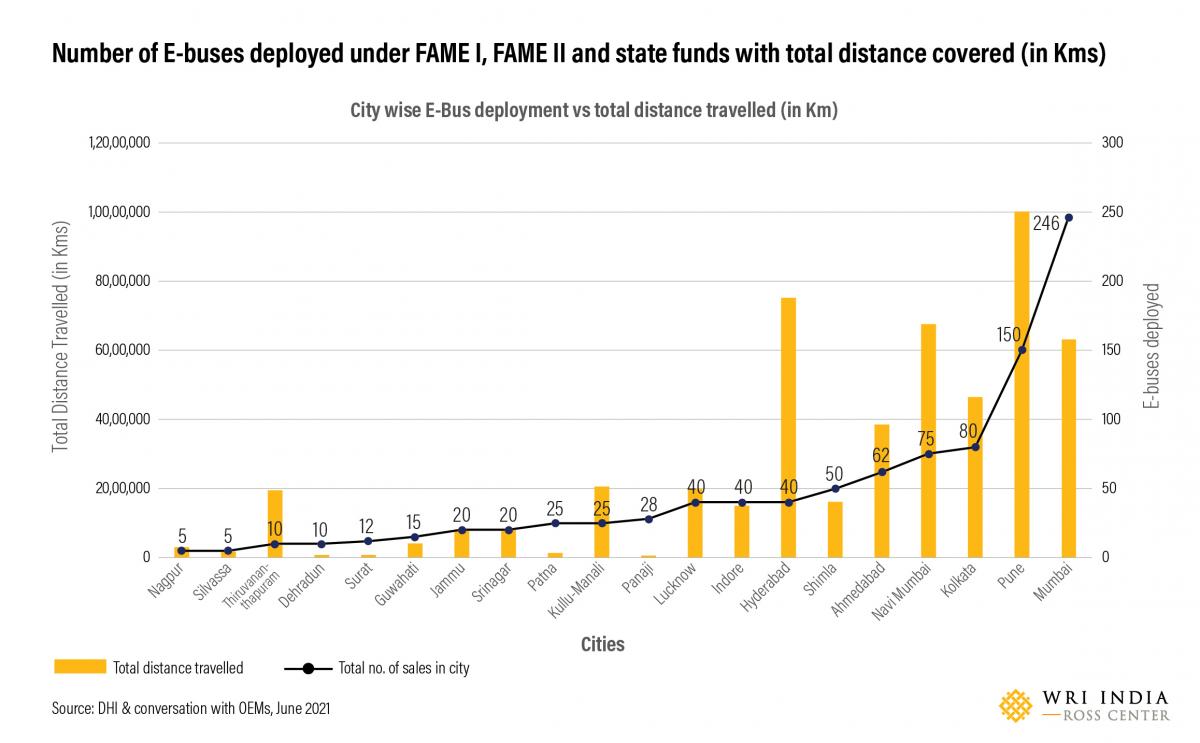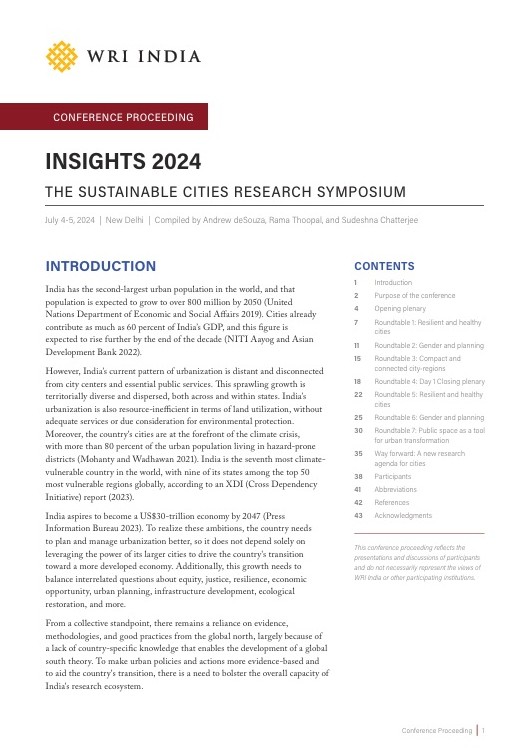Here’s Why India Needs a Comprehensive 2030 Electric Bus Rollout Plan
by , e -
Electrification of public bus transport ranks high on India’s sustainable urban mobility agenda. Pivoting away from Internal Combustion Engine (ICE) driven buses to a pure electric format will have several benefits, including accelerating the pathway to meet the country’s 2070 net-zero target.
To unlock these benefits, e-bus rollout at scale is paramount. Thanks to the financial support available under the Government of India’s subsidy scheme, Faster Adoption and Manufacturing of (Hybrid and) Electric vehicles (FAME), public transit agencies, primarily State Road Transport Undertakings (SRTUs), have made some early progress in transitioning to e-buses. As per the latest records, there are about 1,000 e-buses on roads across the country at present.

Is the current rate of e-bus rollout sufficient?
WRI India’s recent analysis estimates that the country requires over one lakh e-buses by 2030, which is 100 times more than the current deployment. This means there needs to be a significant scaling of e-bus deployment: around11,000 buses each year for the next nine years. Can this be pursued based on an ambitious approach of converting an entire bus fleet to electric in one go? Should future deployment be achieved the way the current e-bus fleet has been implemented?
Let’s analyse the current experience of the SRTUs that have inducted e-buses in their existing fleets.
While some SRTUs have considered e-bus rollout fruitful, others have faced several challenges in the smooth operation of these buses. This has been due to limited driving range, unfamiliarity with managing e-bus charging and setting up high-voltage upstream electrical infrastructure.
As far as the financial impact is concerned, bridging the gap between cost per kilometre of e-buses and earnings per kilometre of a route has been a major barrier to the public transport agencies, especially in cases where the quoted prices from potential bus operators are much higher than anticipated.
These experiences of transit agencies in transitioning to e-bus-based public transport service provide some useful clues into how future e-bus rollouts should be planned. To scale up e-bus deployment, four major action-points are proposed here.
Action 1: Recognize e-bus operation as a new format of transport and adopt an appropriate decision-making framework
The e-bus technology is different from that of a conventional bus and so is its modus operandi. Hence, its rollout calls for a departure in planning. The decision-making framework should broadly hinge on two main considerations:

Financial analysis would require an approach suited to public transport services and should not be seen through the usual lens of project viability. Provision of public transport services is a state-led and state-regulated activity in India. Hence, despite cost-recovery being vital for public transport services, fares have often been kept lower than the cost of service to make it affordable for all income groups. Therefore, for public transport operations, instead of financial viability, financial sustainability is targeted. Similar principle should be applied to the financial decision-making on e-bus adoption.
Action 2: Do not treat e-bus rollout as a subsidy-driven, one-time activity; adopt a mid- to long-term outlook
It is important to bear in mind that tomorrow’s e-bus models are expected to have more efficient drivetrains, advanced batteries and improved Battery Management Systems offering longer driving ranges with same or lower battery pack sizes. Transit agencies should therefore adopt a 2030 e-bus rollout strategy that remains as a living plan warranting periodic reassessment to ensure that the decision-making is relevant in changing market conditions. Additionally, the prices of lithium-ion batteries in the international market continue to decline and may fall below $100/kWh soon – a level regarded as an inflection point for the electric mobility sector. As a result, not only will the economics of route electrification get more attractive, but e-bus rollout will also become favourable on routes that are currently considered technically challenging.
Action 3: Revisit bus operation to reflect the changing realities and explore new revenue streams
Transit agencies should consider the transition to electric mobility as an opportunity to fix transport related issues like falling public bus ridership and dwindling bus fleet size. They should explore ways to reduce cost of e-bus adoption and increase earnings from bus service through better operation planning. For example, by improving fleet utilization, optimizing maintenance practices and expenditure, making demand-responsive changes in routes or service frequencies to increase ridership. Early-stage planning on electricity supply and land management can also improve the economics of e-bus adoption. Moreover, transit agencies should consider employing innovative implementation models (for example, procuring e-buses based on battery leasing, infrastructure cost sharing with other e-bus operators, development of charging infrastructure for captive-cum-public use, etc.) and finding new revenue sources, such as monetizing end-of-first-life batteries.
Action 4: Recognize the economic benefits from e-bus deployment
Governments, at both national and sub-national levels, should regard public transport electrification as an important lever for supporting the country’s climate commitment and mitigating air pollution. It is to be underlined here that the economic benefits of e-bus service far outweigh the initial high cost of e-bus rollout. Therefore, the central government should continue to offer subsidies for e-bus procurement (as currently available under FAME scheme) and the state governments should chip in to extend additional financial assistance to the SRTUs in the form of Viability Gap Funding and interest subvention on loans. From the current state of play, it is clear that e-bus rollout in public transport in India is likely to remain dependent on capital subsidy for the next few years at least. Apart from subsidy, governments must provide land on concession for building support infrastructure and offer promotional electricity tariffs for charging to make e-bus rollout an attractive proposition for transit agencies.
Transitioning a fleet of ICE buses to electric ones requires for all stakeholders to push past the inertia against e-buses, which will entail an approach replete with a holistic vision, robust planning, sustainable financing, and careful execution. In a nutshell, stakeholders including public transit agencies and policymakers have their jobs cut out to make one-lakh plus e-buses on Indian roads by the end of this decade a reality.
For more information on route prioritization and implementation planning for e-bus fleet, visit: Route EValuator
Views are personal.
Shyamasis Das and Anirudh Ray are consultants with the Sustainable Cities and Transport program at WRI India.
About TUMI
Transformative Urban Mobility Initiative (TUMI) is the leading global implementation initiative on sustainable mobility formed through the union of 11 prestigious partners. TUMI supports transport projects all around the world and enables policymakers to transform urban mobility. TUMI supports innovative pilot projects around the world and shares knowledge with planners about modern mobility concepts. earn more about TUMI at: About | (TUMI) (transformative-mobility.org)
About TUMI E-Bus Mission
The TUMI E-Bus Mission is working with six global partners in 20 deep-dive cities to dramatically advance electric bus adoption across leading cities in the Global South. This mission is part of the Action Towards Climate Friendly Transport (ACT) initiative and TUMI, and is supported by the Federal Ministry for Economic Cooperation and Development (BMZ). Learn more about TUMI e-Bus Mission at: https://bit.ly/3pLcSN4
TUMI E-Bus Mission


